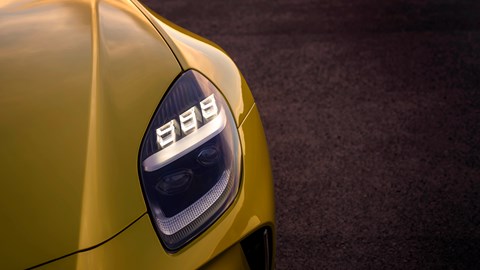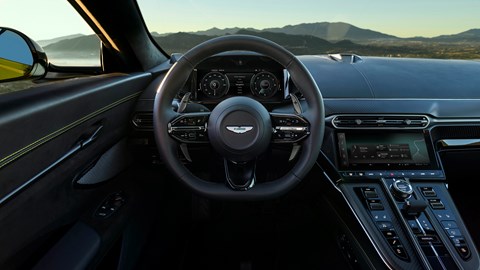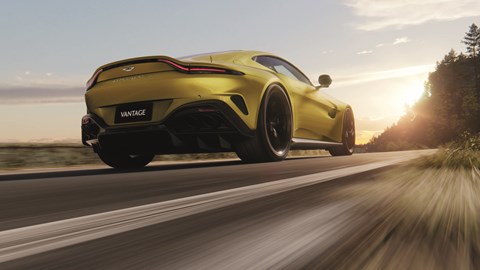► New Aston Martin Vantage first look
► 656bhp, £165k, deliveries spring 2024
► Track-focused GT3 racer also unveiled
The Aston Martin Vantage is the entry-level sports car of the British manufacturer’s range – yet one look at the key stats and you’d have a hard time believing it. Headline figures are 656bhp from a twin-turbocharged 4.0-litre V8, with corresponding improvements to the chassis hardware and driver assist technology, as well as a comprehensive overhaul to the cabin.
The latter was one of the last generation model’s weakest areas and let down what was otherwise an excellent sports car with a broad range of talents. Unfortunately for Aston, the list of rivals is exceptional and includes the Porsche 911, Mercedes-AMG GT and, to a lesser extent, the Bentley Continental GT and Ferrari Roma. Will this latest version of the Vantage be able to compete? Read on to find out.
Similar look, new details
To say the new Vantage has been treated to a spot of copy and paste styling from the previous generation car would be unfair, yet the general shape and image (especially at the rear end) is very similar. That said, the body is 30mm wider and the grille almost 40% larger. Look closely and you’ll also spot a wider front splitter, additional air intakes at the front end, larger exhaust tips and a new Matrix LED headlight design.

The latter differs significantly from the smaller, narrower lights of the old car and gives the new Vantage a front-end look much more in-keeping with its DB12 big brother. What’s more, the side strake on the front flank is more prominent and the standard wheel size is up to 21-inches.
All-new interior
If the exterior is a relatively gentle evolution in design, the cabin upgrade is far more significant. Gone are the days when users were forced to work with an old Volvo or Mercedes-Benz infotainment system, with the new Vantage featuring Aston’s own unit first seen on the DB12. Sufficed to say it’s a vast improvement over what came before it, with Apple CarPlay and Android Auto functionality, as well as 3D mapping, What3Words integration and the ability to connect your car with the official AM app.
Thankfully, in addition to the 10.25-inch central display and equally sized digital dash, the Vantage still comes with a healthy amount of shortcut buttons and dials that should make adjusting functions on the move much easier than delving into a touchscreen. The engine start stop dial doubles up as a drive mode controller, while buttons for the adaptive dampers and exhaust valves also take a prominent position on the centre console.

Meanwhile, the driving position feels much like it did in the previous Vantage with a nice, low-slung base looking out over a long, wide bonnet. Adjustment is ample and the cabin itself should be large enough for most adults.
Our initial look at the Vantage was with a prototype vehicle so we can’t make a final verdict on quality, yet there were a few cheaper-feeling elements including the buttons on the steering wheel and some of the trim around the door cars. As such, we suspect the quality will fall comfortably short of a Porsche 911, yet it’s a strong overall improvement to the cabin nonetheless.
More power, same engine
Many will rejoice in the fact that the AMG-sourced 4.0-litre twin-turbo V8 remains without being touched with the almost inevitable electrification element that’s touching many ICE performance cars. That said, power and torque is up considerably from 503bhp and 505lb ft to a head-turning 656bhp and 590lbt foot. As a result, 0-62mph is down to 3.4 seconds and top speed is said to be 202mph. All fed to the rear wheels only via the tried-and-tested eight-speed ZF auto transmission.
Sadly, there’s no sign of a manual version, yet the ZF ‘box has been treated to a shorter final drive ratio and revised shift calibration in order to deliver better shift times and in-gear acceleration. Meanwhile, the engine achieves its higher outputs via modified cam profiles, a better compression ratio, larger turbos and, naturally, a redesigned cooling system.

This features an additional low temperature radiator and two further auxiliary coolers, with the amount of cold air reaching said radiators increasing by around half. Incidentally, Aston offers a 1770W Bowers and Wilkins 15-speaker 3D sound system with the Vantage, yet we’d hope and expect this to be made redundant when the V8 is on song. Final verdict on that in the upcoming review…
Stiffer chassis, way more tech
The previous Vantage wasn’t all about straight line speed – it impressed in the corners too – yet Aston’s pushed ahead with improvements to the chassis to keep it in line with its lithest of rivals. We’re talking an aluminium structure, 50:50 weight distribution and efforts to improve torsional rigidity. For example, the front cross member has been moved back – thus improving mounting point stiffness for the double wishbone front suspension – while the stiffness between the suspension towers has also been improved at bot the front and rear.
New DTX Bilstein adaptive dampers also feature and deliver five times the bandwidth of force distribution as the previous gen. Bringing this together with the electronic driver aids, of which there are many is the Active Vehicle Dynamics control system which sounds a little but like the six-way Chassis Dynamic Sensor on a Ferrari 296. What it does is measure the car’s movement across a number of different axis and, using this information, acts on the brakes, powertrain and E-Diff to deliver the perfect amount of ESP intervention.

In addition, Adjustable Traction control has been added and, along with off, on Wet and Track ESC modes, the ATC can disable the ESC’s yaw control function and deliver varying levels (from 1-8) of traction control intervention on the throttle. This, in theory, enhancing the possibility of lairy power slides.
One question, however, is all of this does for the Vantage’s weight? The old car came in at 1,530kg dry. The new car gains 75kg and measures 1,605kg dry – essentially the equivalent of carrying a passenger around at all times. Not bad given all the additional strengthening and tech that’s been loaded on.
Verdict
Aston appears to have played the new Vantage very intelligently. It’s kept the things we liked from the previous edition (big V8, handling) and supplemented them with additional firepower and tech, while going back to the drawing board on things we didn’t like (the cabin).
What’s more, the exterior styling has been given a welcome makeover that neatly brings it in line with other Aston products. All that’s left, is to confirm that the character of the old car remains and the various performance and chassis improvements translate into the real world. If they do, then Aston Martin should have a winner on its hands.